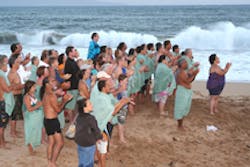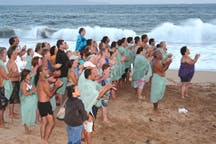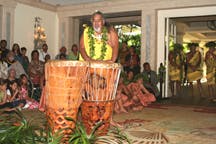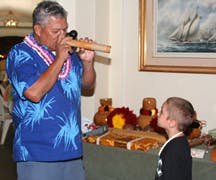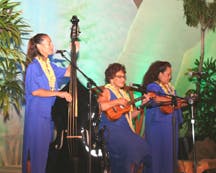THERE'S MORE TO MAUI THAN SUN AND SURF
It's 5:30 in the morning, and I'm shivering on a Maui beach. The sky is still dark, and wind is gusting, testing the resiliency of the palm trees. The waves are crashing into the sand, each one coming closer than the last.
I'm one of about twenty-five people, all in swimsuits, clutching towels and looking either supremely serene or vaguely apprehensive. The serene folks are the Kanaka Maoli [Native Hawaiians] or at least kama'aina [non-Hawaiian islanders]. The apprehensive, like me, are visitors.
We're here to experience Hi'uwai, a traditional Hawaiian purification ceremony. It's the opening event of Maui's annual Celebration of the Arts, a two-day event that honors traditional Hawaiian culture, from music to crafts, from rituals to herbs. It's all part of what Hawaiians hope will lead to a resurgence of pride in their Polynesian past, which many believe has been co-opted by a tourist industry that promotes a Disneyesque atmosphere of cellophane-skirted hula girls and perpetually-grinning ukulele boys.
By about 5:45 the crowd has swelled to fifty, and Clifford Nae'ole, the Hawaiian Cultural Advisor to the Ritz Carleton Hotel in Kapalua, which is hosting the event, begins speaking. "Now it is time for silence," he says. "When you go into the water, think about what you've done, good and bad. When you get out, you'll leave the dirt behind." He calls us to move closer to each other, to stand with shoulders touching, as he intones a chant that I can't understand. Then he waves us towards the water.
I surprise myself by going in, letting the water wash over me. The wind whips my face, blows my hair, and I almost stumble as the water comes in with a roar. As I regain my balance, I sense new possibilities. Maybe there's something to this.
Within about ten minutes, the last few people leave the water, and Nae'ole has us face the east where the sky is getting lighter, a glimmer of pink peaking through the trees. A woman leads us in a chant to awaken the sun. "A new day has begun," says Nae'ole, and he encourages us each to hug the person closest to us. I'm standing near three people; I hug them all.
After I dry off and fill my stomach with coffee harvested on the nearby island of Molokai and toast smeared with roasted pineapple jam, I go to the lobby where a large man in native dress is beating on a four-foot-tall drum and intoning a chant even more haunting than the one on the beach. This, I learn, is the Wehe I
Ka 'lpuka, the opening protocol that honors the elders who have maintained and passed on the traditional heritage.
I begin to wonder, can this be for real? Nae'ole bristles when I ask him if the morning dip and subsequent drum ceremony were just the opening shots in a faux festival, designed to capitalize on the current interest in cultural travel.
"These are as real as it gets," he says firmly. "I would not dare create, invent or dilute our culture. My ancestors would not allow it. What you are experiencing is authentic, genuine and perpetuates all things Hawaiian."
I look around. The majority of guests are Native and resident Hawaiians, folks who have come to celebrate their culture with family and friends. The few Mainlanders came to Maui for a sand, surf and sun vacation and were happily surprised to find, upon arrival, that they'd be able to get a dose of the culture as well.
The Celebration, which is always held over Easter weekend (this year, April 6-7), was started in 1992, the outgrowth of a controversy that could have been disastrous but instead, because of cool heads and sensitive actions on both sides, resulted in warm feelings and a real sense of community.
When construction began on the Ritz Carlton Hotel in 1987, workers discovered that the hotel site was on ancient burial grounds. Work stopped for three years while the dead were re-interred and the hotel redesigned.
Subsequently the hotel, an AAA Five Diamond resort, made a commitment to integrate the history and values of the host culture with their standard leisure-time activities. While many Hawaiian resorts have cultural advisors, Nae'ole, who's been with the resort since the beginning, is among the best. He serves as the event chair of the Celebration of the Arts and runs a variety of programs throughout the year, including walks along bougainvillea-lined paths to the old burial site.
The two days whirl by, a three-ring circus of demonstrations, performances and workshops. The craft demonstrations are spread throughout the resort grounds. People can make nose flutes and quilts, weave with feathers and coconut fronds, carve from stone and whalebone, create necklaces from shells and flowers. Most of the demonstrations are hands-on, and adults have as much fun as little kids.
In the lobby there are ongoing musical performances. The hotel staff sings Hawaiian songs, the children of the Hawaiian Language Immersion Schools perform dances representing different hula traditions and a group of men sing in falsetto voices, demonstrating an art that's tricky and, to the uninitiated, a bit hard on the ears.
At the same time there's an extensive program of serious panels and lectures in various meeting rooms - discussions that revolve around the interplay of culture, commerce and community; the pros and cons of self-government for Hawaii; and the intricacies of Hawaiian herbal healing. The panels mostly attract Island residents, but the few Mainlanders who attend are fascinated. We feel as if we've eavesdropped on a community confab.
The Celebration culminates with a giant lu'au that I'm told is traditional in every way. Yes, it's held in a hotel rather than in someone's backyard, but the food and entertainment will be completely authentic.
It's the only part of the weekend that disappoints. The lu'au is so authentic that I don't know what's going on. I don't understand the songs, which are sung in Hawaiian and, after sampling a variety of mysterious foods, I go back to my room.
On my way I meet a guest who's just returned from the Old Lahaina Lu'au in the nearby whaling-turned-touristy town of Lahaina. "Terrific," he tells me. "The program began with the story of the Polynesian migration across the Pacific, took us through the missionary era and up to today's Hawaii." It might not have been as authentic, but it sounds more interesting. Next time.
Still, I'm sorry when, on Sunday morning, I go to the lobby and it looks.... well, like any other classy beach-and-golf resort. There's an elegant Easter morning buffet, a busy concierge, and guests in Rodeo Avenue golf outfits and swimsuits. But there's no hula dancing.
Nae'ole is preparing to take the day off to be with his family. "The hotel lost money this weekend," he says with a smile, "but what was gained can never be measured. The return on their investment is quantified by the smiles of the children, the cooperation of the elders, the sharing of knowledge by the practitioners, the wonderful impromptu hulas in the lobby...."
I was honored to have been there.
For more information:
Ritz-Carleton Kapalua, 808-669-6200, 800-241-3333, www.ritzcarlton.com/resorts/kapalua/
